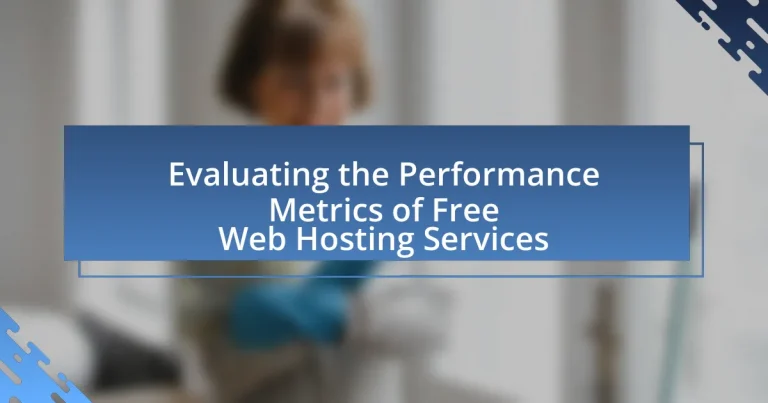The article focuses on evaluating the performance metrics of free web hosting services, emphasizing key factors such as uptime, speed, storage capacity, bandwidth, customer support, and security features. It highlights the importance of uptime and reliability in enhancing user experience, as well as the critical role of speed in retaining visitors and improving search engine rankings. Additionally, the article discusses the limitations of free hosting services, including resource constraints and security risks, while providing best practices for selecting a suitable provider. Users are guided on how to assess performance metrics, identify potential upgrade paths, and optimize their websites for better performance on free hosting platforms.

What are the key performance metrics for evaluating free web hosting services?
The key performance metrics for evaluating free web hosting services include uptime, speed, storage capacity, bandwidth, customer support, and security features. Uptime is crucial as it indicates the reliability of the service, with a standard expectation of 99.9% or higher. Speed affects user experience and search engine rankings, with optimal load times being under three seconds. Storage capacity and bandwidth determine how much data can be hosted and transferred, impacting the site’s performance during traffic spikes. Customer support quality is essential for resolving issues quickly, while security features like SSL certificates and regular backups protect user data. These metrics collectively provide a comprehensive assessment of a free web hosting service’s effectiveness and reliability.
How do uptime and reliability impact user experience?
Uptime and reliability significantly enhance user experience by ensuring that websites and services are consistently accessible. High uptime rates, typically above 99.9%, lead to fewer disruptions, allowing users to engage with content without frustration. For instance, a study by the Aberdeen Group found that a one-second delay in page load time can result in a 7% reduction in conversions, highlighting the direct correlation between uptime, reliability, and user satisfaction. Reliable services foster trust, encouraging users to return, while frequent downtimes can lead to negative perceptions and loss of audience.
What is the significance of uptime percentage in web hosting?
Uptime percentage is crucial in web hosting as it directly reflects the reliability and availability of a website. A high uptime percentage, typically above 99.9%, indicates that the hosting service is consistently operational, minimizing downtime and ensuring that users can access the website without interruptions. For instance, a hosting provider with 99% uptime may experience approximately 7.2 days of downtime annually, which can significantly impact user experience and business operations. Therefore, uptime percentage serves as a key performance metric for evaluating the effectiveness of web hosting services, particularly in free hosting options where reliability may vary.
How can downtime affect website traffic and user trust?
Downtime negatively impacts website traffic and user trust by causing users to be unable to access the site, leading to lost visitors and potential revenue. When a website experiences downtime, it can result in a significant drop in traffic; for instance, a study by Google found that 53% of mobile users abandon sites that take longer than three seconds to load. This abandonment can lead to decreased user engagement and lower search engine rankings, as search engines prioritize sites with high availability. Furthermore, repeated downtime can erode user trust, as customers may perceive the website as unreliable. According to a survey by the Harris Poll, 78% of consumers would stop engaging with a brand after experiencing a negative online interaction, which includes website downtime. Thus, consistent uptime is crucial for maintaining both traffic levels and user trust.
What role does speed play in the performance of free web hosting services?
Speed is a critical factor in the performance of free web hosting services, as it directly impacts user experience and site accessibility. Faster loading times lead to lower bounce rates and higher user engagement, which are essential for retaining visitors. Research indicates that a one-second delay in page load time can result in a 7% reduction in conversions, highlighting the importance of speed in achieving effective performance metrics. Additionally, search engines like Google consider site speed as a ranking factor, meaning that slower free hosting services may negatively affect a website’s visibility and traffic.
How is website loading speed measured?
Website loading speed is measured using various metrics, primarily Time to First Byte (TTFB), First Contentful Paint (FCP), and Fully Loaded Time. TTFB measures the time taken for the server to respond to a request, while FCP indicates the time it takes for the first piece of content to appear on the screen. Fully Loaded Time tracks the duration until all resources on the page are completely loaded. These metrics are commonly assessed using tools like Google PageSpeed Insights, GTmetrix, and WebPageTest, which provide detailed insights into loading performance and help identify areas for improvement.
What factors contribute to slow loading times in free hosting services?
Slow loading times in free hosting services are primarily caused by limited server resources. Free hosting providers often allocate minimal CPU, RAM, and bandwidth to each user, resulting in slower response times during peak usage. Additionally, these services may utilize shared servers, where multiple websites compete for the same resources, further degrading performance. According to a study by Google, a one-second delay in loading time can lead to a 20% decrease in user satisfaction, highlighting the impact of resource limitations on user experience.
How does customer support influence the evaluation of free web hosting services?
Customer support significantly influences the evaluation of free web hosting services by directly impacting user satisfaction and service reliability. When users encounter issues, responsive and effective customer support can resolve problems quickly, enhancing the overall experience. According to a survey by Zendesk, 82% of consumers have stopped doing business with a company due to poor customer service, highlighting the critical role support plays in user retention and satisfaction. Thus, the quality of customer support is a key performance metric that users consider when evaluating free web hosting services.
What types of customer support are typically available with free hosting?
Free hosting services typically offer limited customer support options, primarily including community forums, knowledge bases, and email support. These support channels allow users to seek assistance from other users or access self-help resources, but they often lack real-time support such as live chat or phone assistance. According to a survey by HostingAdvice, 70% of free hosting providers do not offer direct customer service, emphasizing the reliance on community-driven support.
How can the quality of customer support affect user satisfaction?
The quality of customer support directly influences user satisfaction by determining how effectively issues are resolved and how valued users feel. High-quality customer support leads to quicker resolution times, which enhances user experience and fosters loyalty. According to a study by Zendesk, 82% of consumers have stopped doing business with a company due to poor customer service, highlighting the critical role support quality plays in user retention and satisfaction.

What are the limitations of free web hosting services?
Free web hosting services have several limitations, including restricted storage space, limited bandwidth, and lack of customer support. These services often impose caps on the amount of data users can store and transfer, which can hinder website performance and accessibility. Additionally, free hosting typically includes advertisements, which can detract from the user experience and brand image. Security features are often minimal or non-existent, making websites more vulnerable to attacks. Furthermore, users may face restrictions on the types of content they can host, and they usually do not have a custom domain name, which can affect credibility. According to a study by HostingAdvice, 70% of users reported dissatisfaction with the performance of free hosting services, highlighting these common drawbacks.
Why are resource limitations a concern for users of free web hosting?
Resource limitations are a concern for users of free web hosting because they can significantly restrict website performance and functionality. Free web hosting services often impose strict limits on bandwidth, storage, and processing power, which can lead to slow loading times, downtime, and an inability to handle traffic spikes. For instance, a study by HostingAdvice found that 70% of users experienced slower website speeds due to these limitations, negatively impacting user experience and search engine rankings. Consequently, these constraints can hinder the growth and effectiveness of a website, making resource limitations a critical issue for users relying on free hosting options.
What are the typical resource caps imposed by free hosting providers?
Free hosting providers typically impose resource caps that include limited storage space, bandwidth restrictions, and reduced processing power. For instance, many free hosting services offer storage ranging from 500 MB to 2 GB, while bandwidth limits can vary from 1 GB to 10 GB per month. Additionally, these providers often restrict CPU usage and memory allocation, which can hinder website performance and scalability. Such limitations are designed to encourage users to upgrade to paid plans for enhanced resources and capabilities.
How do these limitations affect website performance and scalability?
Limitations in free web hosting services significantly hinder website performance and scalability. These limitations often include restricted bandwidth, limited storage, and lack of server resources, which can lead to slow loading times and increased downtime. For instance, a study by HostingAdvice found that websites on free hosting platforms can experience loading times exceeding 10 seconds, negatively impacting user experience and search engine rankings. Additionally, as traffic increases, the inability to scale resources can result in server overload, causing websites to crash or become unresponsive. This directly affects the site’s ability to handle user requests efficiently, ultimately limiting growth and user retention.
What security risks are associated with free web hosting services?
Free web hosting services pose several security risks, including data breaches, malware infections, and lack of support for security updates. These services often have inadequate security measures, making them vulnerable to attacks. For instance, a study by the Cybersecurity & Infrastructure Security Agency (CISA) highlights that free hosting platforms frequently lack encryption and robust firewalls, increasing the likelihood of unauthorized access to sensitive information. Additionally, users may share server resources with potentially malicious sites, further heightening the risk of cross-site scripting and other vulnerabilities.
How do free hosting services typically handle security measures?
Free hosting services typically implement basic security measures, such as limited encryption and firewalls, to protect user data. These services often lack advanced security features due to budget constraints, which can leave users vulnerable to attacks. For instance, many free hosting providers do not offer SSL certificates, making data transmission less secure. Additionally, they may rely on shared hosting environments, increasing the risk of cross-site vulnerabilities. According to a study by the International Journal of Information Security, free hosting services are more susceptible to security breaches compared to paid options, highlighting the importance of understanding these limitations when choosing a hosting provider.
What vulnerabilities should users be aware of when using free hosting?
Users should be aware of several vulnerabilities when using free hosting, including limited security measures, data privacy risks, and potential for service interruptions. Free hosting services often lack robust security protocols, making websites susceptible to hacking and malware attacks. Additionally, user data may not be adequately protected, leading to privacy breaches, as many free hosts monetize by selling user data. Furthermore, free hosting can experience frequent downtime or slow performance due to resource limitations, impacting website accessibility and user experience. These vulnerabilities highlight the risks associated with relying on free hosting solutions for critical online presence.
How does advertising impact the user experience on free web hosting platforms?
Advertising negatively impacts the user experience on free web hosting platforms by introducing distractions and reducing site performance. Users often encounter intrusive ads that can disrupt navigation and content consumption, leading to frustration. A study by the Nielsen Norman Group found that excessive advertising can decrease user satisfaction and engagement by up to 30%. Additionally, ads can slow down page load times, which is critical for user retention; research indicates that a one-second delay in load time can lead to a 7% reduction in conversions. Thus, while advertising provides revenue for free services, it compromises the overall user experience significantly.
What types of ads are commonly displayed on free hosting services?
Free hosting services commonly display banner ads, pop-up ads, and text ads. Banner ads are graphical advertisements that occupy a section of the webpage, while pop-up ads appear in new browser windows, often interrupting user experience. Text ads, typically displayed as links or small text boxes, are integrated within the content or sidebar of the site. These ad types are prevalent because they generate revenue for the hosting provider, allowing them to offer free services to users.
How can ads affect website branding and user engagement?
Ads can significantly impact website branding and user engagement by influencing user perceptions and interactions with the site. Effective advertising can enhance brand visibility and recognition, leading to increased trust and loyalty among users. For instance, a study by Nielsen found that 60% of consumers are more likely to engage with brands that have consistent advertising across multiple platforms. Conversely, poorly placed or intrusive ads can detract from user experience, causing frustration and potentially leading to higher bounce rates. Research indicates that 70% of users prefer ad-free experiences, which can negatively affect engagement metrics if ads are perceived as disruptive. Thus, the balance and quality of ads directly correlate with both branding effectiveness and user engagement levels.

What are the best practices for choosing a free web hosting service?
The best practices for choosing a free web hosting service include evaluating reliability, understanding limitations, checking customer support, and assessing performance metrics. Reliability is crucial; select a service with minimal downtime, ideally under 99.9% uptime, as this ensures your website remains accessible. Understanding limitations involves recognizing storage, bandwidth, and feature restrictions that may hinder your website’s growth. Customer support is essential; opt for services that offer responsive support channels, as this can significantly impact your ability to resolve issues quickly. Lastly, assess performance metrics such as loading speed and server response time, as these factors directly affect user experience and search engine rankings.
How can users assess the performance metrics of different free hosting options?
Users can assess the performance metrics of different free hosting options by analyzing key indicators such as uptime, loading speed, bandwidth, and customer support responsiveness. Uptime refers to the percentage of time the hosting service is operational, with a benchmark of 99.9% being ideal. Loading speed can be measured using tools like Google PageSpeed Insights, which provides insights into how quickly a website loads on various devices. Bandwidth indicates the amount of data that can be transferred over a given time, affecting how many visitors a site can handle simultaneously. Customer support responsiveness can be evaluated through user reviews and response time metrics available on platforms like Trustpilot. These metrics collectively provide a comprehensive view of the reliability and efficiency of free hosting services.
What tools can be used to compare uptime and speed across providers?
Tools that can be used to compare uptime and speed across providers include Pingdom, UptimeRobot, and GTmetrix. Pingdom offers real-time monitoring of website uptime and performance metrics, allowing users to track response times and downtime incidents. UptimeRobot provides a straightforward interface for monitoring uptime at five-minute intervals, delivering alerts when downtime occurs. GTmetrix analyzes page speed and performance, offering insights into load times and recommendations for improvement. These tools are widely recognized for their reliability and accuracy in measuring the performance of web hosting services.
How can user reviews and testimonials inform the decision-making process?
User reviews and testimonials can significantly inform the decision-making process by providing firsthand insights into the experiences of individuals who have utilized free web hosting services. These reviews often highlight specific performance metrics such as uptime reliability, customer support responsiveness, and ease of use, which are critical factors for potential users. For instance, a study by BrightLocal in 2022 found that 91% of consumers read online reviews, and 84% trust them as much as personal recommendations, indicating that user feedback can heavily influence choices. By analyzing patterns in reviews, prospective users can identify strengths and weaknesses of various hosting services, allowing for more informed and confident decisions.
What should users consider regarding future scalability when selecting a free hosting service?
Users should consider the limitations of resource allocation when selecting a free hosting service for future scalability. Many free hosting services impose strict limits on bandwidth, storage, and server performance, which can hinder the ability to accommodate increased traffic or data as a website grows. For instance, a study by HostingAdvice found that 70% of free hosting providers restrict bandwidth to less than 1 GB per month, making it challenging for businesses to scale effectively. Additionally, users should evaluate the upgrade paths offered by the hosting provider, as seamless transitions to paid plans can facilitate growth without significant downtime or migration issues.
How can users identify potential upgrade paths with free hosting providers?
Users can identify potential upgrade paths with free hosting providers by analyzing the limitations and features of the free service. Many free hosting providers outline their upgrade options on their websites, detailing the benefits of paid plans, such as increased storage, bandwidth, and customer support. For instance, users can look for specific metrics like uptime guarantees, speed performance, and resource allocation, which are often highlighted in comparison charts. Additionally, user reviews and forums can provide insights into the experiences of others who have upgraded, revealing the advantages and drawbacks of different plans. This information helps users make informed decisions about when and how to upgrade their hosting services.
What indicators suggest a hosting service may not support future growth?
Indicators that suggest a hosting service may not support future growth include limited scalability options, inadequate bandwidth, and poor customer support. Limited scalability options indicate that the service cannot accommodate increased traffic or resource demands, which is crucial for growing websites. Inadequate bandwidth can lead to slow loading times and downtime during peak usage, negatively impacting user experience and retention. Poor customer support can hinder timely resolution of issues, further stalling growth. These factors collectively signal that a hosting service may struggle to adapt to the evolving needs of a growing online presence.
What tips can help users maximize their experience with free web hosting services?
To maximize their experience with free web hosting services, users should carefully evaluate the features and limitations of the hosting provider. Users should prioritize services that offer sufficient bandwidth and storage to accommodate their website needs, as many free hosts impose strict limits that can hinder performance. Additionally, users should look for providers that offer reliable uptime guarantees, ideally above 99%, to ensure their website remains accessible. Security features, such as SSL certificates and regular backups, are also crucial for protecting user data and maintaining site integrity. Furthermore, users should take advantage of community support and documentation provided by the hosting service, as these resources can help troubleshoot issues and optimize site performance.
How can users optimize their website for better performance on free hosting?
Users can optimize their website for better performance on free hosting by minimizing file sizes and utilizing efficient coding practices. Reducing image sizes through compression tools and using formats like WebP can significantly decrease load times. Additionally, employing clean, well-structured HTML, CSS, and JavaScript helps improve rendering speed.
Implementing caching techniques, such as browser caching and using Content Delivery Networks (CDNs), can further enhance performance by reducing server load and speeding up content delivery. According to Google, optimizing images can lead to a 30% reduction in page load time, which is crucial for user experience and SEO.
Furthermore, limiting the use of heavy plugins and scripts can prevent slowdowns, as excessive requests can overwhelm free hosting resources. Regularly monitoring website performance using tools like Google PageSpeed Insights can provide actionable insights for ongoing optimization.
What common troubleshooting steps can users take to resolve issues with free hosting?
To resolve issues with free hosting, users should first check their internet connection to ensure it is stable and functioning properly. A weak or intermittent connection can lead to accessibility problems. Next, users should clear their browser cache and cookies, as outdated data can cause loading issues. Additionally, verifying that the hosting service is not experiencing downtime or outages is crucial; users can check the service’s status page or social media for updates. If problems persist, users should review their website’s configuration settings, ensuring that domain names are correctly pointed to the hosting server. Finally, reaching out to the hosting provider’s support team can provide specific guidance tailored to the user’s situation. These steps are effective as they address common technical issues that can arise with free hosting services.


